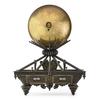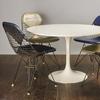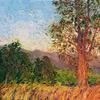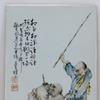Major Collection of Delft Showcased by Aronson Antiquairs at 2013 Winter Antiques Show
- AMSTERDAM, Netherlands
- /
- January 17, 2013
Aronson Antiquairs is offering its collection of 22 Samuel van Eenhoorn Delftware pieces – a cache larger than those owned byAmsterdam’s Rijksmuseum and the Musee Royaux in Brussels.
Fifth generation Dutch Delft dealer ROBERT ARONSON of ARONSON ANTIQUAIRS of Amsterdam (www.aronson.com), is showcasing ”The most successful of all the early Delft factories, De Grieksche A, (The Greek A)” at the 2013 WINTER ANTIQUES SHOW in New York from January 25 -February 3. The extraordinary 17th century Delftware collection of 22 marked and several attributed pieces of Samuel van Eenhoorn (1655-85) is a cache larger than the leading museums in the field and is on offer for the first time in New York.
Robert Aronson says, “Delftware produced by the De Grieksche A factory was known for its superb craftsmanship, even referred to as “porcelain” during a time when wars in China limited access to Chinese export porcelain by Europeans. At its pinnacle the potters of Delft had about 30 factories with the De Grieksche A works the leading provider to royal and aristocratic clients throughout Europe. When Samuel van Eenhoorn was given the company as a wedding gift by its founder, his father Wouter, who died shortly thereafter, he greatly expanded the firm’s international contacts and success, which extended from Amsterdam to London, Hamburg and Bordeaux. He enjoyed the patronage of the House of Orange, as evidenced by archaeological excavations at Het Loo Palace in Apeldoorn which have unearthed garden ornaments and tulip vases marked SVE.“
“Our Samuel van Eenhoorn exhibition at The Winter Antiques Show of 22 pieces will be the largest to date – the Rijksmuseum in Amsterdam has 16 marked pieces and the Musee Royaux in Brussels owns only six. Our prices range from 4,500 Euros for a marked plate to 58,000 Euros for a rare pair of bulb-neck vases.”
Unfortunately, Samuel van Eenhoorn had an early death just seven years after inheriting the Delft factory: he died in 1685. That accounts for the extreme rarity of his marked works.
Aronson says that stylistically Samuel van Eenhoorn was known for his skill painting chinoiserie decorations showing carefully executed facial expressions and clothing.
“He captured the 17th century popularity of Kangxi blue-and-white porcelain and was said to have created the blue-black or violet outline as well as different shades of glaze from light blue to grey-green and white. He also employed decorative Far East scenes and motifs in his work including floral scrolls and tulip stems. He used manganese rather than cobalt blue imparting a purple-blue color to some rare pieces.”
Samuel van Eenhoorn pieces are so rare they hardly ever come up at auction. At a 2005 London sale a vase, lacking its cover, fetched $40,000 and an uncovered tea caddy sold for $16,000 at a 2000 Amsterdam auction.
“Samuel van Eenhorn also became an important voice for the Delft master potters and shop-owners, going to England in 1684 to protest the 1672 embargo on imports of Dutch pottery,” according to Aronson.
The De Grieksche A Delft factory continued to flourish after Samuel’s death. His widow sold it to her brother-in-law Adriaen Kocks in 1687 and he created extremely high quality Delftware until his death in 1701. He manufactured a great array of shapes from jars and bowls to tea caddies and plates and used his talent creating designs based on Kangxi porcelain to produce incredible scenes replete with lambrequin motifs and scallops. Significant vases and jugs were created for ceremonial rooms at Hampton Court, commissioned by William II of Orange, the King of England and his wife Mary Stuart.
Aronson says, “We are thrilled to have acquired such a superb array of these very rare and important examples of Dutch Delftware that have not previously been available. I never lose the thrill of showing something this special to a true Delft connoisseur.”
“Our show underscores how rare the best Dutch Delftware is. While many pieces I have sold to collectors and museums reach six or seven figures, there are a lot of very important examples still to be had for far far less. We are delighted to work with a new collector to start them on their own collection.”
Among top examples of Samuel van Eenhoorn Delft at The Winter Antiques Show this year you will find a Delft Blue and Manganese Chinoiserie Posset Pot and Cover, circa 1695-1705 marked SVE T, 8 and 7/8 inches high and 11 and 1/4 inches wide.
“Posset Pots were a common form in the Netherlands and England in the late 17 and early 18th centuries although recipes for “Posset” can be found in cookery books dating to the 14th and 15th centuries. Posset was basically wine or liquor mixed with curdled milk and had both a medicinal and social function, often being given to new mothers or serving as a nightcap. A variety of ingredients is said to have been added at times ranging from eggs, sugar, cream, spices and fruit to thickeners such as oatmeal, barley, bread or biscuits. The spouted posset pot allowed one to suck up the liquor underneath the mixture without getting a wet nose!”
Another star attraction is a Pair of Blue and White Vases with ‘Beast and Ring’ Handles dating to 1680-85, each marked SVE 4 in blue, for Samuel van Eenhoorn.
Aronson says, “The shape of these ‘altar vases’ was derived from French faience examples. Archeologist Nina Jaspers discovered that similarly shaped vases applied with colored garlands and putti, produced by Les Trois Mores Factory in Nevers circa 1620-40, were present in the Netherlands in the 17th century. As these French designs were inspired by 16th and 17th century Italian prototypes, these vases are significant because it provides incontrovertible proof that this model was produced in Delft as well. The shape is also known in French silver.”
Each ovoid body is painted with a continuous scene of Chinese figures amidst rocks, pines and shrubbery with an attendant holding a large fan and standing between two seated dignitaries. On the reverse side two men are conversing over a low table. The shoulders of the vases have tall animal head handles suspending rings from their mouths above the human mask terminals. The domed foot has a ruyi-head and scroll border beneath a modified ‘chain’ band around the ankle. The vases are 10 and ¾ inches high.
A third Samuel van Eenhoorn Delft piece is a Small Blue and White Octagonal Ewer circa 1680-85, also with a blue SVE mark.
“This is the kind of focal point piece everyone appreciates in their collection,” Aronson says. “The baluster form of the ewer is painted with Chinese tasseled emblems suspended from a bowknot within four panels alternating with two panels of flowering plants or two panels of a bird singing by a flowering plant, all beneath a border of petal-shaped lappets. It is 5 and 13/16 inches high.”
Other Samuel van Eenhoorn Delft works for sale at The Winter Antiques Show include a blue and white Chinoiserie Octafoil Dish; a baluster-form Vase and cover in blue and manganese; a pair of Chinoiserie bottle-form Vases in blue and white; and a blue and manganese Chinoiserie Plate which Aronson says, “Was meant solely for decoration. Even ceramic producers ate off wooden plates at the time, so called ‘teljoren.’ The ridge that we see in the ceramic plates comes from the ridge that was needed in metal (pewter) plates. This would prevent the metal plate from warping, something not possible in ceramics.”
BACKGROUIND
Robert Aronson says, “The Netherlands introduced the production of earthenware in the first half of the 15th century as trade with Italy, Spain and Portugal brought fine pieces of earthenware to the Netherlands. By the 17th century the Dutch East India Company had introduced Europe to Chinese porcelain and exports flourished as the West strived to duplicate the Chinese formula for fine blue and white porcelain. When war in China interrupted the trade, potters in Delft expanded their businesses to create earthenware versions of ‘porcelain.’ In fact, The word “Delftware” only came to describe items made after 1650. “
“At the height of production The Guild of Saint Luke counted more than 30 factories in the small city of Delft. They were innovative and adapted to fill the needs of clients all over Europe, with the term ‘Delft’ becoming synonymous with 'Faience.”
Robert Aronson has added a modern twist to the business by embracing 21st century technology and e-commerce in ways his forebears could never have imagined. “I’ve given Aronson Antiquairs a contemporary outlook that best serves both new collectors and old, using the latest tools, from Facebook and Twitter to You Tube video. Now, in whatever way that is most convenient for them, people interested in learning about Dutch Delft may examine our unrivaled collections, and come to understand the unique qualities of Delftware -- more easily than at any time in our company’s 130 year history.”
Aronson Antiquairs numbers among its clients the world’s leading connoisseurs as well as major museums including The Wadsworth Museum, the Metropolitan Museum of Art, The British Museum and Holland’s own Rijksmuseum.
Robert Aronson is on the Board of The European Fine Arts Fair (TEFAF in Maastricht each March) and is chairman of The Dutch Antique Dealers Association. His late father, Dave Aronson, headed TEFAF for a decade before his death six years ago.
“Regardless of whether you visit us at fairs, come to our galleries in Amsterdam or shop at our web sites at www.aronson.com and shop.aronson.com there is truly no greater way to learn about and enjoy Dutch Delftware. No one has greater access to the best pieces entering the market. And it is always our pleasure to help new collectors gain the knowledge and confidence they need to build a truly satisfying collection.”
IF YOU GO
ARONSON ANTIQUAIRS at
THE 2012 WINTER ANTIQUES SHOW
January 25 – February 3
Park Avenue Armory at 67th Street
ARONSON ANTIQUAIRS
Nieuwe Spiegelstraat 39
Amsterdam-Center

100x100_n.jpg)
100x100_c.jpg)













100x100_c.jpg)